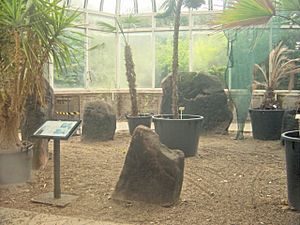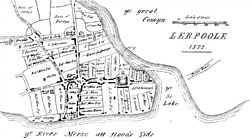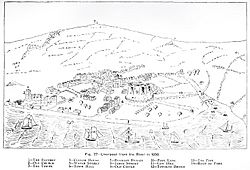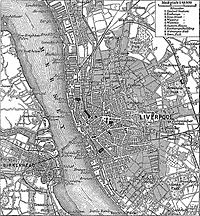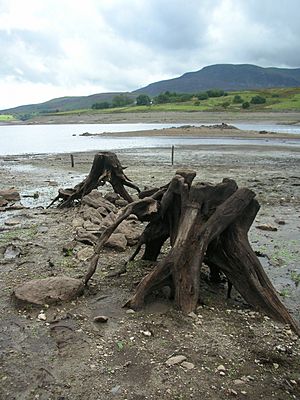History of Liverpool facts for kids
The history of Liverpool is a fascinating journey! This famous city started small but grew into a major port and cultural hub. Its name, 'Liuerpul', first appeared in 1190 and might mean a muddy water pool.
King John officially founded Liverpool in 1207 with a special document called a royal charter. Back then, it was just seven streets shaped like the letter 'H'. For a long time, Liverpool was a small town. But then, its trade changed from nearby places like Ireland to faraway lands like Africa and the Caribbean. This included the sad slave trade.
In 1715, the world's first commercial wet dock was built in Liverpool. This helped the city grow even faster over the next 200 years. By the 1800s, a huge amount of goods passed through Liverpool. In 1830, the Liverpool and Manchester Railway opened, which was a world first!
Many people, especially from Ireland, moved to Liverpool. By 1851, one-quarter of the city's population was Irish-born. Liverpool became known as "the second city of the British Empire" and even "the New York of Europe."
During World War II, Liverpool was key to planning the important Battle of the Atlantic. The city was heavily bombed, second only to London.
After the mid-1900s, Liverpool's docks and factories faced tough times. New ways of shipping goods, like containerisation, made the old docks less useful. Unemployment became very high.
However, starting in the 1960s, Liverpool became famous worldwide for its culture, especially the "Merseybeat" music sound, made famous by The Beatles. In recent years, Liverpool's economy has improved, thanks to tourism and big projects to rebuild parts of the city. In 2008, Liverpool was even named the European Capital of Culture.
Contents
- What Does the Name Liverpool Mean?
- Early History of the Liverpool Area
- How the Town of Liverpool Began
- Liverpool in the Elizabethan Era and Civil War
- Growth of Transatlantic Trade
- Liverpool and the Slave Trade
- Industrial Revolution and City Growth
- Liverpool in the 20th Century
- Recent History of Liverpool
- Images for kids
What Does the Name Liverpool Mean?
The word "pool" is common in English place names. It comes from an old word meaning a pond, inlet, or pit. The first part of "Liverpool" is a bit of a mystery.
One idea is that it comes from the Welsh word Llif, which means flood or current, and was an old name for the Atlantic Ocean. This fits with an old Welsh name for Liverpool, Llynlleifiad, meaning "the lake/pool that floods."
Another idea is "elverpool," referring to the many eels in the River Mersey. The name "Liuerpul" first appeared in 1190.
Early History of the Liverpool Area
During the Iron Age, the area around Liverpool didn't have many people. There was a seaport at Meols. The Calder Stones are believed to be part of an ancient stone circle. Archeologists have found evidence of Iron Age farms in places like Irby and Halewood.
The area was home to Brythonic tribes. Around 70 AD, the Roman Empire took control. The main Roman base was at Chester. The Romans called the River Mersey Seteia Aestuarium, named after the Setantii tribe.
After the Romans left, native Britons continued to farm the land. The region saw fighting between different kingdoms. The Anglo-Saxon Kingdom of Mercia eventually won control. Some place names from this time, like Walton and Wallasey, mean "farmstead of the foreigners," referring to the native Celtic people.
Around 902 AD, Viking settlers from Dublin came to the Wirral Peninsula. They formed a small Viking state with other Norse settlers in west Lancashire. They held meetings at places called þing (pronounced "thing"), like Thingwall in Wirral and Thingwall in West Derby. This area later became part of the Danelaw, which was ruled by the Vikings.
How the Town of Liverpool Began
While a small Norman castle was built earlier at West Derby, the city of Liverpool officially started on August 28, 1207. On this date, King John issued a special document inviting people to settle in a new town called "Livpul." The King likely wanted a port that wasn't controlled by the Earl of Chester.
At first, Liverpool was a place to send troops to Ireland. Around 1235, Liverpool Castle was built, but it was later removed in 1726. St Nicholas Church was built by 1257. In the 1200s, Liverpool only had seven streets.
With a market set up where the Town Hall is today, Liverpool became a small community focused on fishing and farming. It was run by local officials and a mayor. There was some trade around the Irish Sea and ferries across the Mersey. However, for several centuries, Liverpool remained a small and not very important settlement. In the mid-1300s, its population was less than 1,000.
By the early 1400s, the town faced tough economic times. The Stanley family built a fortified house on Water Street, which caused rivalry with the Molyneux family, who lived in Liverpool Castle. By the mid-1500s, Liverpool's population had dropped to about 600. It was considered less important than Chester until the 1650s.
Liverpool in the Elizabethan Era and Civil War
In 1571, the people of Liverpool asked Queen Elizabeth for help, saying they were "her majesty's poor decayed town of Liverpool." This shows how small and struggling the town was.
By the end of the 1500s, Liverpool began to recover. It started to take trade from Chester, especially as the River Dee became harder for ships to use. Liverpool traded with Ireland, the Isle of Man, and other places. In 1626, King Charles I gave the town a new and better charter.
In June 1644, during the English Civil War, Prince Rupert of the Rhine arrived with 10,000 soldiers to capture Liverpool Castle. A 16-day siege took place. The Parliament Army dug a huge trench across the town to defend it. Prince Rupert eventually took the castle but was soon driven out. He took refuge in the Everton area, which is why the tower on the Everton Football Club badge is called Prince Rupert's Tower.
Growth of Transatlantic Trade
The first goods from the Americas arrived in Liverpool in 1648. The town grew quickly after 1660, thanks to increasing trade with America and the West Indies. Liverpool soon became the second most important city in Great Britain.
At first, goods like cloth, coal, and salt from Lancashire and Cheshire were traded for sugar and tobacco. Liverpool's first sugar factory opened in 1670. In 1699, Liverpool became its own parish, separate from Walton-on-the-Hill. This also gave it its own customs authority, separate from Chester.
Liverpool and the Slave Trade
On October 3, 1699, the same year Liverpool became an independent parish, its first recorded slave ship, the Liverpool Merchant, sailed to Africa. It arrived in Barbados with 220 enslaved Africans. The ship returned to Liverpool in September 1700.
Britain's first wet dock was built in Liverpool and finished in 1715. It was the world's first commercial enclosed wet dock, built to hold 100 ships. By the late 1700s, 40% of the world's and 80% of Britain's Atlantic slave trade came from Liverpool's.
Liverpool's black community began with the building of the first dock in 1715. It grew quickly, reaching 10,000 people within five years. This growth led to the opening of the United States Consulate in Liverpool in 1790, the first US consulate anywhere in the world.
Huge profits from the Atlantic slave trade made Liverpool one of Britain's most important cities. It became a financial hub, second only to London. In 1799, a peak year, ships from Liverpool carried over 45,000 enslaved people from Africa.
Many things led to the end of slavery, including revolts and social unrest. William Roscoe, a politician born in Liverpool, led the anti-slavery movement in parliament. Slavery in British colonies was finally abolished in 1833. Slave trading was made illegal in 1807. However, some merchants continued to deal in illegal slave trafficking.
Industrial Revolution and City Growth
Liverpool's international trade grew, not just with slaves, but also with many other goods, especially cotton. The city became the world's main market for cotton, supplying factories in Manchester and Lancashire.
During the 1700s, Liverpool's population jumped from about 6,000 to 80,000. Its connections by land and water to other northern cities also improved. Liverpool was linked by canal to Manchester in 1721 and Leeds in 1816. In 1830, Liverpool became home to the world's first inter-city railway link to Manchester, with Stephenson's famous train, The Rocket.
Liverpool was home to many world firsts. It had the world's first fully electric overhead railway, the Liverpool Overhead Railway, which opened in 1893. This was even before similar railways in New York City and Chicago.
The city's built-up area grew rapidly from the 1700s. The Bluecoat Hospital for poor children opened in 1718. After the castle was demolished in 1726, only St Nicholas Church and the old street plan remained. The Town Hall, designed by John Wood, was built in 1754.
Throughout the 1800s, Liverpool's trade and population continued to boom. As the cotton trade grew, strong links were made with India and the Far East. Between 1824 and 1858, over 140 acres (0.57 km²) of new docks were opened, with 10 miles (16 km) of quay space.
During the 1840s, thousands of Irish migrants arrived due to the Great Famine. In 1847 alone, almost 300,000 arrived. By 1851, about 25% of the city's population was Irish-born. This Irish influence is seen in Liverpool's unique political history. It's the only place outside Ireland to elect a member of parliament from the Irish Parliamentary Party to the British parliament. T.P. O'Connor represented Liverpool Scotland from 1885 to 1929.
As Liverpool became a leading port of the British Empire, many grand buildings were constructed, including St. George's Hall (1854) and Lime Street Station. The Grand National horse race first ran at Aintree in 1837.
Between 1851 and 1911, Liverpool attracted at least 20,000 people from Wales every decade. Welsh culture thrived, with over 50 Welsh chapels in the city.
When the American Civil War began, Liverpool became a center of activity. Because of its cotton and slave interests, Liverpool was very supportive of the Confederacy. The Confederate ship, the CSS Alabama, was built in Birkenhead on the Mersey.
Liverpool was granted city status in 1880. The following year, its university was established. By 1901, the city's population had grown to over 700,000. Its boundaries expanded to include areas like Kirkdale, Everton, and Toxteth.
Liverpool in the 20th Century
Early 1900s: Growth and Challenges
In the early 1900s, Liverpool continued to grow, attracting immigrants from Europe. An International Exhibition took place in Edge Lane in 1903. In 1904, the building of the Anglican Cathedral began. By 1916, the three famous Pier Head buildings, including the Liver Building, were finished. This time was the peak of Liverpool's economic success, when it saw itself as the "second city" of the British Empire.
More areas like Allerton and Childwall were added to the city in 1913. The parish of Speke was added in 1932, leading to large housing developments.
The maiden voyage of the Titanic in April 1912 was originally planned to leave from Liverpool. Liverpool was its home port and where its owners, White Star Line, were based. However, it ended up departing from Southampton.
Besides the large Irish community, Liverpool also had other diverse groups. An area off Scotland Road was known as Little Italy. Liverpool also had a large Welsh population and was sometimes called the Capital of North Wales. Welsh festivals called Eisteddfods were held in Liverpool in 1884, 1900, and 1929. The city's population reached its highest point, over 850,000, in the 1930s.
Economic changes began in the early 1900s. Less worldwide demand for the North West's traditional goods led to stagnation and decline in the city. Unemployment was higher than the national average as early as the 1920s.
When Everton F.C. won the Football League First Division title in 1928, their player Dixie Dean scored a record 60 goals in one season.
The Great Depression hit Liverpool hard in the early 1930s, leaving thousands jobless. To help, the local council built many new houses, creating jobs in construction. About 15% of the city's population was rehoused in the 1920s and 1930s, with over 30,000 new council houses built to replace slums.
The rise of cars caused traffic jams. In 1934, Liverpool got its first direct road link to the Wirral Peninsula when the first Mersey Tunnel road, called the Queensway, opened. Many other buildings were built in the 1930s to help with the depression.
World War II: 1939-1945
During World War II, Liverpool was the control center for the Battle of the Atlantic. The city suffered eighty air-raids, with a very heavy series of raids in May 1941. About 2,500 people were killed, and almost half the homes in the area were damaged. Over 70,000 people lost their homes. John Lennon, a member of The Beatles, was born in Liverpool during an air-raid on October 9, 1940. All four members of The Beatles were born in the city during the war.
Post-War Changes: 1946-1979
After the war, there was a lot of rebuilding, including huge housing estates and the Seaforth Dock, Britain's largest dock project. However, from the 1950s, Liverpool lost many jobs. By 1985, the population had fallen to 460,000. The decline in factories and dock activity hit the city very hard.
In 1956, Liverpool City Council wanted to build a water reservoir in the Tryweryn Valley in Wales, which would flood the village of Capel Celyn. This was very controversial because it was one of the last Welsh-only speaking communities. Most Welsh politicians opposed it, but the plan was approved in 1957. The village was flooded in 1965. This event led to a big rise in Welsh nationalism.
In the 1960s, Liverpool became a center of youth culture. The city created the unique Merseybeat sound, and, most famously, The Beatles.
From the 1970s, Liverpool's docks and traditional factories continued to decline. New shipping methods meant Liverpool's docks were no longer a major employer. In 1974, Liverpool became a metropolitan district within the new county of Merseyside.
The 1980s: Tough Times and Football Success
The 1980s were a very difficult time for Liverpool. The 1970s had brought economic problems, but the situation got much worse in the early 1980s. Many factories closed, and unemployment rates were among the highest in the UK. About 12,000 people left the city each year.
In July 1981, the Toxteth Riots took place. In the same year, the Tate and Lyle sugar factory, a big employer, closed. The docks had already declined, removing another major source of jobs.
Liverpool City Council faced financial problems in the 1980s. The council fought against the government reducing funding for local services. This led to many councillors being removed from office for refusing to cut the budget.
On April 15, 1989, 96 Liverpool F.C. fans died in the Hillsborough disaster at a football match in Sheffield. This was a very sad event for people across the country, especially in Liverpool. It led to big changes in how football fans are looked after, including making all top English stadiums all-seater.
There was controversy because some newspapers, like The Sun, wrongly blamed Liverpool fans. Many people in Liverpool still refuse to buy The Sun today. Later, it became clear that the police made mistakes. In 2014, a new inquest found that the 96 victims were unlawfully killed.
Despite the city's economic problems, Liverpool F.C. had great success in the 1970s and 1980s. The club, formed in 1892, won many league titles and European trophies. By 1990, Liverpool FC had won more major trophies than any other English club. Famous players like Kevin Keegan and Kenny Dalglish played for the club.
Everton F.C., the city's other main football club, also had success in the 1970s and 1980s. In 1984, Everton won the FA Cup. They won a league title in 1985 and their first European trophy. In 1986, Liverpool and Everton were the top two clubs in England, and they met in the FA Cup final, which Liverpool won. Everton also won another league title in 1987.
The 1990s saw the city continue to rebuild and improve.
Recent History of Liverpool
Since the mid-1990s, Liverpool has seen a general economic and civic revival. Its economy has grown faster than the national average. Crime rates are lower than in many other big cities in England and Wales.
In recent years, Liverpool has focused on its cultural attractions. Tourism has become very important to Liverpool's economy, especially because of the popularity of The Beatles and other Merseybeat groups. In June 2003, Liverpool was chosen to be the European Capital of Culture for 2008. The city's riverfront was also named a World Heritage Site in 2004.
In October 2005, Liverpool City Council officially apologized for flooding Capel Celyn in Wales. They acknowledged the hurt caused and hoped to restore the good relationship between Liverpool and Wales.
Images for kids
-
By 1957, the once-great Liverpool tramway system had been reduced to just two routes, the 6A to Bowring Park and the 40 to Page Moss Avenue. These routes finally closed in September. All were in a run-down and dilapidated condition, sad to see. Here is a 'Baby Grand' 4-wheel tram on the Bowring Park route.


